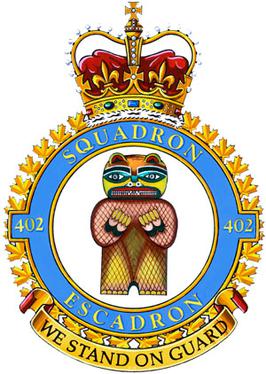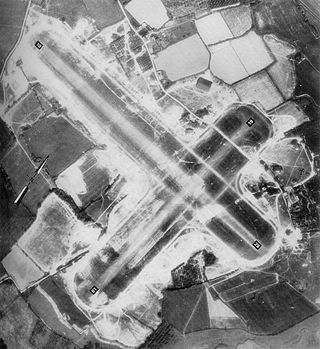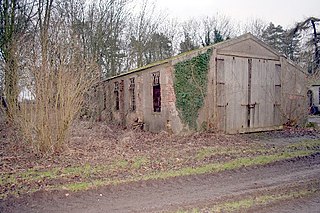
Royal Air Force Kenley, more commonly known as RAF Kenley is a former airfield station of the Royal Flying Corps in the First World War and the RAF in the Second World War. It played a significant role during the Battle of Britain as one of the three RAF stations specifically tasked with the defence of London. It is located near Kenley on the edge of Greater London. The site remains in use with the Ministry of Defence, as Kenley Airfield.

Royal Air Force Leeming or more simply RAF Leeming is a Royal Air Force station located near Leeming, North Yorkshire, England. It was opened in 1940 and was jointly used by the RAF and the Royal Canadian Air Force (RCAF). Between 1950 and 1991, it operated mostly as a training base with Quick Reaction Force (QRF) Panavia Tornado F3 fighters based there in the latter stages of the Cold War and into the early 21st century. Since 2006, it has become the home of the deployable RAF communications cadre and the home of No. 135 Expeditionary Air Wing.

Royal Air Force Tangmere or more simply RAF Tangmere is a former Royal Air Force station located in Tangmere, England, famous for its role in the Battle of Britain.

Royal Air Force Leconfield or more simply RAF Leconfield is a former Royal Air Force station located in Leconfield, East Riding of Yorkshire, England.

No. 331 Squadron RAF was a Second World War squadron of the Royal Air Force. The squadron was primarily manned with Norwegian aircrew. The squadron was part of Fighter Command between 1941 and March 1944 when it joined the 2nd Tactical Air Force until the end of the war. The squadron took part in the Dieppe Raid and the Normandy landings.

Number 19 Squadron is a squadron of the Royal Air Force. It was the first squadron to operate the Supermarine Spitfire. It currently operates the UK's Control and Reporting Centre from RAF Boulmer. No. 19 Squadron delivers persistent surveillance of UK airspace, and Tactical Control of RAF and NATO aircraft, including the UK's contribution to NATO's Quick Reaction Alert mission.

402 "City of Winnipeg" Squadron is a Royal Canadian Air Force squadron based in Winnipeg, Manitoba, Canada

Army Aviation Centre (AAC) Middle Wallop is a British Army airfield located near the Hampshire village of Middle Wallop, used for Army Air Corps training. The base hosts 2 (Training) Regiment AAC and 7 (Training) Regiment AAC under the umbrella of the Army Aviation Centre. 2 (Training) Regiment performs ground training; 7 (Training) Regiment trains aircrew on AAC aircraft after they complete basic training at RAF Shawbury.

Royal Air Force Staplehurst or more simply RAF Staplehurst is a former Royal Air Force Advanced Landing Ground located in Kent, England. The airfield is located approximately 1 mile (1.6 km) northeast of Staplehurst; about 38 miles (61 km) southeast of London.

Royal Air Force Fairwood Common, or more simply RAF Fairwood Common, is a former Royal Air Force Sector Station located on Fairwood Common, on the Gower Peninsula, to the west of Swansea. It is now the location of Swansea Airport.

Royal Air Force East Moor or RAF East Moor is a former Royal Air Force satellite station located 7.4 miles (11.9 km) north of York, North Yorkshire and 5.5 miles (8.9 km) south-east of Easingwold, North Yorkshire, England.

The 350th Squadron is a fighter squadron in the Air Component of the Belgian Armed Forces. It was originally formed in 1941 as No. 350 (Belgian) Smaldeel of the Royal Air Force during World War II. The unit was transferred to the Belgian Air Force, together with 349th Squadron, in 1946. Based at Florennes air base, the unit is now part of the 2nd Tactical Wing and operates F-16 Fighting Falcons.

Royal Air Force Hawkinge or more simply RAF Hawkinge is a former Royal Air Force station located 13.23 miles (21.29 km) east of Ashford, 2.2 miles (3.5 km) north of Folkestone, Kent and 7.1 miles (11.4 km) west of Dover, Kent, England. The airfield was used by both the Royal Flying Corps and the Royal Air Force during its lifetime and was involved during the Battle of Britain, as well as other important aerial battles during the Second World War and the early stages of aerial usage in war in the First World War.
Royal Air Force Angle or more commonly RAF Angle, is a former Royal Air Force station located on the Angle Peninsula Coast, 8 miles (13 km) west of Pembroke, Pembrokeshire, Wales. It was operational from 1 June 1941 to 11 July 1946, having been used by both the Royal Air Force and the Royal Navy.

Royal Air Force Thorney Island, or more simply RAF Thorney Island, is a former Royal Air Force station located on Thorney Island, West Sussex, England, 6.6 miles (10.6 km) west of Chichester and 7.1 miles (11.4 km) east of Portsmouth, Hampshire.

443 Maritime Helicopter Squadron is a Canadian Armed Forces helicopter squadron under the Royal Canadian Air Force (RCAF), located on Vancouver Island, British Columbia. It was originally a Second World War RCAF squadron that operated as part of RAF Fighter Command in Europe with the Supermarine Spitfire.

No. 401 Tactical Fighter Squadron, a.k.a. "City of Westmount" Squadron, is a Royal Canadian Air Force squadron based at CFB Cold Lake. During World War II it was a fighter squadron and is notable for having fought in the Battle of Britain. Postwar, the squadron operated in Canada as an auxiliary squadron, reserve squadron and a helicopter and training squadron. In 2015 it was reactivated as a tactical fighter squadron.
No. 124 (Baroda) Squadron RAF was a Royal Air Force Squadron formed to be a light bomber unit in World War I and reformed as a fighter unit in World War II.

Royal Air Force Wellingore or more simply RAF Wellingore is a former Royal Air Force fighter relief landing ground located 1.9 miles (3.1 km) south of Navenby, Lincolnshire and 10 miles (16 km) south of Lincoln, Lincolnshire, England.



















